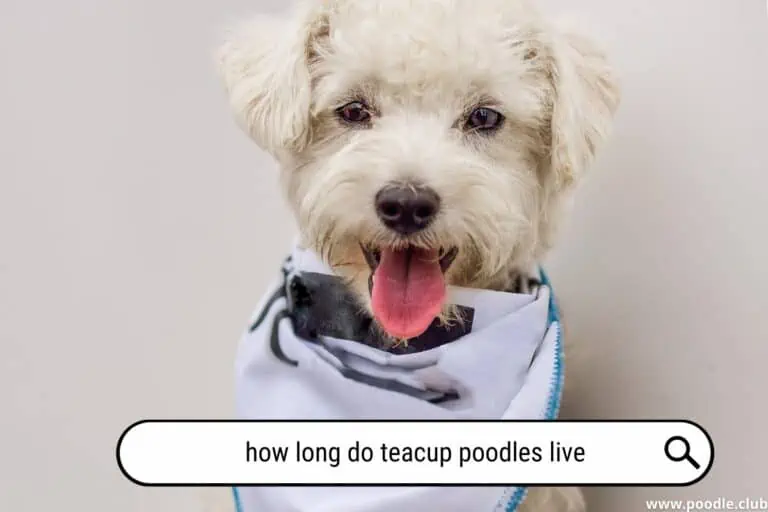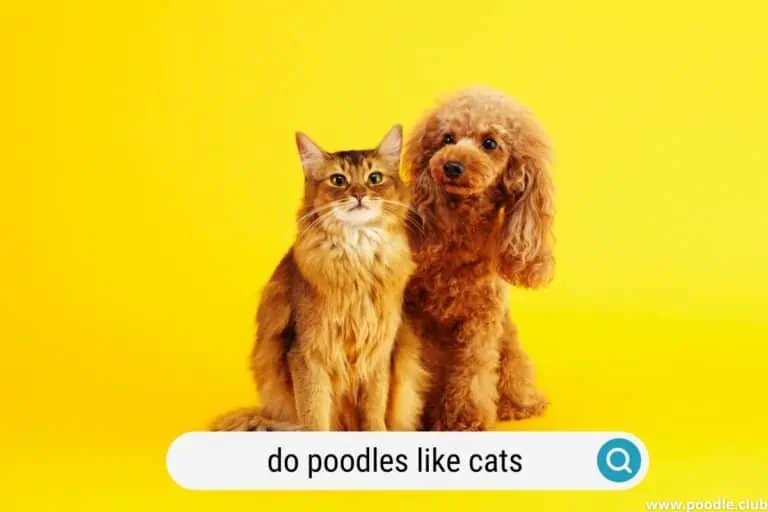Do Poodles Have Fur or Hair [How To Tell]
Are poodles clad in hair or fur? This question has puzzled many, so let’s shed some light on the matter. Simply put, unlike most breeds, Poodles have hair, not fur.
Here’s why.

The Basics of Poodles’ Coats
Both hair and fur are made of keratin, a protein in mammals. Their growth patterns and textures set them apart. Hair grows continuously and is finer, whereas fur, thicker in nature, has a short growth cycle. In this regard, poodles are unique. Their thick, curly coat is more like hair – it grows continually, needing regular grooming to avoid tangles and maintain neatness.
Having hair has benefits too. Poodles rarely shed, and their hair is less allergenic, making them a suitable choice for allergy sufferers or those who don’t want a fur-covered home. Thus, whenever you spot a poodle, remember they’re part of a special breed clad in hair, not fur.
Hair vs Fur
Poodles are unique among dog breeds, as they have hair rather than fur. This distinction might seem trivial, but it has significant consequences for their shedding habits, grooming requirements, and potential for triggering allergies.
For example, a poodle’s hair will continually grow, like human hair, while a dog with fur will typically shed seasonally. As a fluffy, hypoallergenic high-five for poodle owners, this means they will shed considerably less. However, a wild summer ‘do? Totally possible – better schedule that salon appointment for Fido.
Texture Differences
When it comes to texture, Poodle hair exhibits a wide range of curliness, density, and softness depending on their genes and grooming. Some poodles come equipped with a luxurious coat that could give any supermodel a run for their money, while others sport curls tighter than a spiral staircase.
PuppySpot is a reputable dog marketplace where you can browse and find compatible puppies right from the comfort of your home. They have placed over 200,000 puppies into homes in the US!
This diversity in texture makes poodles oh-so-fashionable, but it also requires some extra care to keep their locks looking tip-top. Regular grooming and brushing can help prevent matting and tangles, ensuring that your pampered pooch stays the talk of the dog park.
Growth Cycle Differences
Another notable characteristic of poodle hair is its longer growth cycle. Unlike fur, which typically has a faster growth rate and shorter active growth phase, poodle hair grows more slowly and spends more time in the active growth phase (known as the anagen phase) before eventually shedding.
What does this mean for poodle parents? Well, just as you wouldn’t let your hair grow wild and unkempt (unless, of course, that’s your style), you can’t just let a poodle’s hairdo run free without some regular TLC. So, embrace the longer growth cycle, invest in some grooming tools, and enjoy the bonding moments with your ever-fashion-forward poodle companion!
Poodle Varieties and Coat Types
Poodles are often admired for their elegant appearance, intelligence, and low-shedding coats. These features are present across all three main types of Poodles: Standard, Miniature, and Toy. Each variety has unique characteristics, but they all share the same distinctive curly coat.
Standard Poodle
The Standard Poodle is the largest of the three Poodle varieties, standing at over 15 inches tall at the shoulder. Their coats are dense and curly, with a texture that is often compared to lamb’s wool.
There is a common misconception that Poodles have hair rather than fur; although their coat does have similarities to human hair in terms of growth patterns, it’s still considered fur.
The adult coat of a Standard Poodle is typically curly or wavy, with the option for owners to groom it into various styles, such as the classic “pom-pom” look or the more practical “sporting clip.”
Miniature Poodle
Miniature Poodles are slightly smaller than the Standard Poodle, standing between 10 and 15 inches tall at the shoulder. Like their larger cousin, Miniature Poodles also have a dense, curly fur coat. Their adult coats can sport the same variety of grooming styles seen in Standard Poodles, with the added benefit of requiring less time and effort due to their smaller size. Despite their size, Miniature Poodles still maintain the elegance and grace that the Poodle breed is known for.
Toy Poodle
The smallest of the Poodle varieties, the Toy Poodle, stands under 10 inches tall at the shoulder. Even at this petite size, their coats remain dense and curly, much like the Standard and Miniature Poodles. Toy Poodles’ adult coats can be groomed into a variety of styles to showcase their adorable size and charming personalities.
In conclusion, all Poodle varieties share a strikingly similar coat type, characterized by dense curls or waves. While all three types – Standard, Miniature, and Toy – have unique features that set them apart, they all can be admired for their distinctive curly fur, elegant appearance, and intelligence.
So whether you’re a fan of the stately Standard, the marvelous Miniature, or the tantalizing Toy, one thing is certain: there’s a Poodle out there that’s perfect for you!
Grooming and Maintenance
Shedding and Matting
Poodles are known for their hypoallergenic curly hair that doesn’t shed like fur on other dog breeds. But don’t let that fool you into thinking Poodle maintenance is a walk in the park (unless that park has a grooming salon). Since their hair keeps growing, it can get tangled and matted if not cared for properly. That’s where good grooming practices come in handy!
Brushing Techniques
To prevent matting and tangling, regular brushing is a must for Poodles. Start by choosing the right brush: a slicker brush or a comb specifically designed for curly-haired dogs. When brushing, work through small sections of hair at a time, gently untangling any knots. Remember to hold the hair at the base to avoid pulling on your dog’s skin. Keep your Poodle looking like a million “barks” by doing this at least a couple of times a week.
Haircuts and Styles
Poodles are runway-ready with their numerous haircut and style options. From the classic “teddy bear” cut to the fancier “continental” clip, your Poodle can rock a variety of looks depending on how creative (or daring) you’d like to be.
Regular trips to the groomer, about once every 4-6 weeks, are crucial to keep your Poodle looking stylish and feeling comfortable. Keep in mind that longer styles require more maintenance, so choose a haircut that suits both you and your Poodle’s needs. After all, a well-groomed Poodle is a happy Poodle!
Hypoallergenic Qualities
Dander and Allergens
Poodles are often referred to as hypoallergenic dogs due to their unique hair-like coat. Unlike most dog breeds, poodles do not have fur; instead, they possess tightly curled hair that helps prevent the spread of pet dander and allergens. This characteristic makes them a popular choice among individuals with allergies. However, it’s important to note that no dog is completely hypoallergenic, as all dogs produce dander and allergens to varying degrees.
The proteins Can f 1 and Can f 2, commonly found in pet dander, are responsible for causing allergic reactions in some people. Interestingly, studies have shown that Poodles have higher levels of Can f 1 compared to other breeds. Nevertheless, due to their unique hair-like coat, allergens seem to adhere to the hair better, reducing the amount of allergens shed into the environment.
An analogy to help understand this would be to think of the poodle’s hair as a sponge, soaking up and retaining any allergens, while traditional fur coats act more like feather dusters, spreading allergens throughout the house. Sounds convenient, right?
Health Benefits for Allergy Sufferers
Though no dog is 100% hypoallergenic, poodles can still offer significant health benefits for those who suffer from pet-related allergies. Since the curly-haired coat of a poodle retains more allergens, it can lead to a decrease in the number of allergens disbursed into the air, reducing allergic reactions for sensitive individuals.
However, it’s essential to maintain proper grooming and cleaning practices to keep allergen levels low. Regular brushing, bathing, and cleaning your poodle’s living environment will help minimize allergens and provide a more comfortable experience for allergy sufferers.
It’s like owning a luxurious vacuum cleaner that not only looks adorable but also takes care of some allergens. Who wouldn’t want that?
While poodles may be a better choice for people with allergies, they’re not a magical cure-all. Always consult with an allergist and spend time around poodles before making a decision to bring one into your family. Happy hypoallergenic living!
Poodle Coat Colors and Changes
Color Varieties
Poodle coat colors come in a delightful variety that makes them a favorite among dog enthusiasts. Some popular colors include:
- Black
- White
- Apricot
- Blue
- Silver
- Brown
- Red
For instance, a black Poodle’s coat may eventually develop brown or apricot hairs, revealing its heterozygous nature for coat color ¹.
Puppy to Adult Coat Transition
Poodles have a unique and interesting coat transition as they grow from puppies to adults. For example, a Poodle that appears dark as a puppy might gradually lighten up as it matures. This transformation period can be a little bit of a “hair-pulling” experience for Poodle owners, as they anxiously anticipate the final coat color of their dog.
Hormonal Changes Impact on Coat
Hormonal changes can also play a role in altering the Poodle’s coat color–but don’t worry, your Poodle isn’t just going through a rebellious phase! In some cases, these changes lead to alterations in pigment intensity. A study found that there were equal numbers of melanocytes in Poodle skin hair bulbs, but hormonal changes could impact the expression levels of certain genes, resulting in color variations.
To sum it up (without concluding anything, of course), Poodles are a bundle of surprises when it comes to their coats. From color varieties to the fascinating transitions from puppy to adult coats and the effects of hormonal changes, Poodles keep their humans guessing! Enjoy the journey while your Poodle struts its fabulous coat, and embrace the mystery. After all, variety is the spice of life, right?
Comparing Poodle Coats to Other Breeds
Golden Retriever
Golden Retrievers have a double coat, which consists of a dense, water-repellent outer coat and a thick, insulating undercoat. This combination keeps them warm in colder climates and allows them to swim effortlessly. On the other hand, Poodles have a curly, non-shedding hair coat that grows continuously, requiring regular grooming. Poodle coats are great for allergy sufferers, as they produce less dander compared to dogs with fur like Golden Retrievers.
Yorkshire Terrier
Yorkshire Terriers have a single coat made up of silky, long, and straight hair that can grow quite long if left untrimmed. These small dogs have more hair than fur, which can be similar to Poodles, although Poodles have a curly texture. Interestingly, a study found that both the Poodle and Yorkshire Terrier breeds have higher allergen levels than other breeds, debunking the myth of hypoallergenic dogs.
Bichon Frise
Bichon Frise, like Poodles, are famous for their fluffy, low-shedding hair. While their hair is more wavy than curly, it shares some similarities with Poodle coats. Both breeds require regular grooming to prevent matting and to maintain a tidy appearance. The coat of a Bichon Frise can also provide a good example of what to expect when looking at certain mixed breeds, such as Poodle-Bichon mixes known as Poochons.
Overall, it’s clear that Poodle coats stand out among various dog breeds. They offer the advantage of reduced shedding, which can be beneficial for those with allergies, while also requiring regular grooming to keep their curls looking fabulous. Each breed has its uniqueness; Golden Retrievers are adaptable swimmers, Yorkshire Terriers flaunt their long silky tresses, and the Bichon Frise is a delightful cloud of fluffiness.


![Are Poodles Affectionate? [True Nature]](https://poodle.club/wp-content/uploads/2023/05/are-poodles-affectionate-768x512.webp)


![Are Poodles Retrievers [Breed Trait]](https://poodle.club/wp-content/uploads/2023/05/are-poodles-retrievers-768x512.webp)
